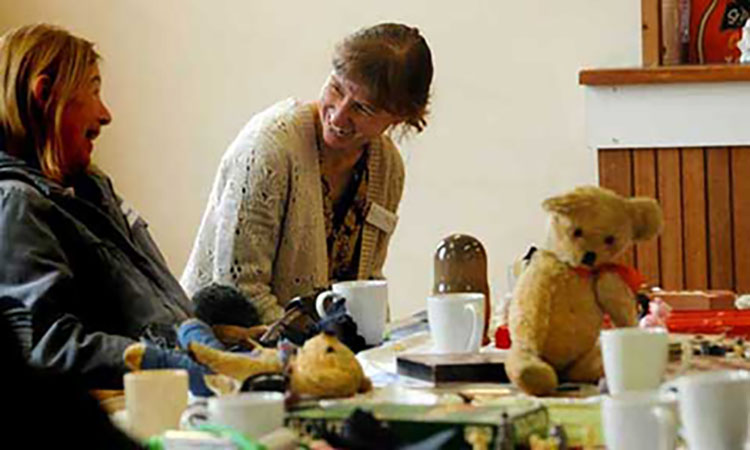
What do we mean by ‘dementia friendly communities’?
One of a series of images for the Joseph Rowntree Foundation’s Dementia Friendly York programme by photographer Elly Ross
Janet Dean of Dean Knight Partnership is working with Qa Research and AESOP to evaluate the Joseph Rowntree Foundation’s Dementia Friendly Communities programmes in York and Bradford.
The term is becoming more widely used, but in her first guest blog for Qa Research, Janet asks: do you understand what it means?
If I asked you what was meant by the phrase dementia friendly communities, what would you say?
Perhaps you would say a community which cares for people with dementia, by providing support services and excellent care, by looking after our most vulnerable people.
Or a community which is easy to find your way around, without too many signs and difficult road layouts.
Or a community which is patient with people who need to go a bit slower, to have more time to work things out.
If you said any of those things, you’d be right.
But it’s more than that.
In the Evaluation of the Joseph Rowntree Foundation’s dementia friendly communities programmes in Bradford and York, Qa is using the Four Cornerstones model which Janet Crampton, Ruth Eley and I developed in our original research Creating a Dementia Friendly York.
The four cornerstones – place, people, resources and networks – help us to think about people’s lives in the round, not just in terms of health and social care services.
Let me explain what I mean.
Place
This is about considering where people are, where they live, and their whole environment from their bedroom, whole house, street, neighbourhood, to the transport they use to get around.
These are some of the questions we might ask to check whether somewhere is a dementia friendly place:
- Home – is it easy to manage, move around, peaceful and comfortable?
- The neighbourhood – is it easy to walk around with even pavements and a good distinction between pedestrian and traffic areas? Are sign posts clear?
- Public transport – are buses and trains frequent, accessible and well signposted, with friendly staff who have been trained in dementia awareness?
People
Here we mean the loved ones, wider family, carers, and others in regular contact who help people with dementia to have the best lives they can.
They do this by understanding what dementia means and how to support what people can do as much as compensate for what they can’t.
Some of the questions we might ask are:
- Does the person with dementia have personal support from family members or professional carers, and what understanding do they have of dementia?
- Who does the person with dementia see regularly who might notice changes in behaviour or confusion and be able to help?
- Is there a health or social care professional who provides a point of contact for advising them and their family about how to deal with changes as they occur?
- Are the needs of close family carers understood and supported?
Resources
This covers every service that a person with dementia might use – including the every day services that we all use.
This gives us the opportunity to engage everybody from the local library, to the bank, to the care home manager in becoming dementia friendly.
Think about these questions:
- How can everyday services be improved to help people with dementia? This question led to a re-think about alternatives to banking PIN numbers. Opticians, hairdressers, butchers and taxi drivers have made simple changes to the way they support people with dementia after undergoing training.
- How can people with dementia and their carers know which resources in their area are dementia friendly? An Alzheimer’s Society scheme sees businesses raise their awareness and display a Dementia Friendly sign.
- How can we ensure that health and social services accommodate the particular needs of people with dementia, who are often their most prevalent and vulnerable users? Awareness and training on dementia is being delivered on general hospital wards and in generic services to non-specialist staff.
Networks
Networks can be the hardest cornerstone to grasp. It is a way to consider how professionals and the whole community work together to support people with dementia.
We can ask how people with dementia are supported by groups of peers or people in the local area. And how technology connects people with dementia across the community and beyond.
Some of our questions might be:
- How do professional and voluntary organisations collaborate to support people with dementia – whilst maintaining confidentiality, and enabling personal choice?
- What opportunities are there for people with dementia to connect with others in the community for mutual support and to improve the quality of their lives?
- How can technology connect people with dementia to their friends, families and the world? Smartphones, tablets and laptops can help them join in through social media, games and music.
At the core of our evaluation of the JRF Dementia Friendly Communities Programme are these four cornerstones.
We think they all need to be in place to fully support people with dementia live the best lives they can.
And they work for the rest of us too – we might all benefit from a simpler, kinder, more supportive community – because if something is good for people with dementia it’s good for us all.
For more information about Qa’s involvement with the evaluation:
Kay Silversides
Call: 01904 632039



